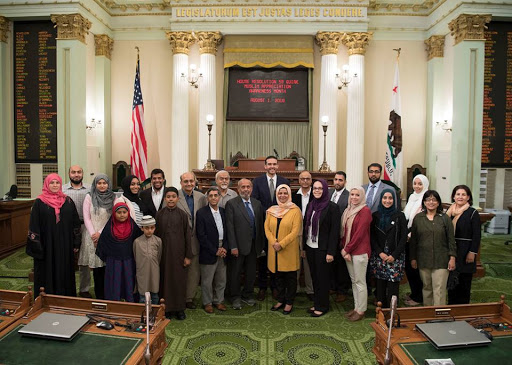Here’s what we know about the Asian American electorate as election season comes into full swing: They are still the fastest-growing racial segment nationwide, expected to double in number as voters by 2040. They’ve strongly aligned with the Democratic party. They may be the swing vote in states like Nevada, Virginia and California, where they make up more than 5 percent of the population.
Which is to say – background players? No longer. It’s also why Asian American and Pacific Islander organizations and advocates are increasing efforts to grow the AAPI electorate more than ever.
Last week, members of the Congressional AAPI Caucus stood together on stage as speaker invitees for the first time, led by Caucus Chair Rep. Judy Chu, who reminded the nation that AAPIs “have gone from being marginalized to becoming the margin of victory in key swing states and districts all across our nation.”
In an interview with Kore, Chu said speaking at the DNC was history in the making. “That was the first time the Caucus was put in the national area, and we conveyed a message there, to make sure people knew about us, and that we are changing,” Chu said. “We are finding our voice.”
The Asian American voter population, currently at an estimated 6 million, is projected to make up 10 percent of all voters by 2044, according to APIAVote. For more than a decade, about 600,000 new Asian American voters have entered the electorate each presidential cycle. This year saw the highest number of AAPI Congressional candidates, at 40, up from 10 candidates in 2010.
“We’re looking to break the glass ceiling, and to make sure we have AAPIs in the top levels of our government,” Chu said, pointing to people like Judge Lucy Koh, a Korean American who was nominated by President Barack Obama to serve on the U.S. Court of Appeals for the Ninth Circuit earlier this year.
Chu said that she sees a need for increased voter contact by both Democrats and Republicans, who “have not done a great job in reaching out,” to bring out Asian electorate to voting booths.
The non-partisan Asian Americans Advancing Justice has been doing that job for years in conjunction with dozens of other community organizations, by conducting in-language phone banking and hosting community forums. Kelly Osajima, the voter engagement manager for AAAJ Los Angeles, said phone banking by 150 volunteers, dialed in 12 languages including Chinese, Korean, Vietnamese, Japanese, Hindi, Urdu, Thai, Tagalog, Samoan and Tongan, reached 35,000 inactive or newly registered voters for the June primary. The goal is to hit another 35,000 before the November election.
“Oftentimes, these voters don’t ever get contacted by mainstream political campaigns,” Osajima said. Most recent data suggests that about 55 percent of all eligible AAPIs are registered to vote, and that, of those registered, only 65 percent cast a ballot in 2012. “It’s not that AAPIs don’t vote because they’re apathetic,” she said. “There’s barriers for folks who don’t speak English, or those who don’t have that one-on-one contact. We’re trying to break down that barrier.”
One new initiative for the group this year is voter registration. Their projects include visiting high schools and colleges, targeting young people through social media campaigns and partnering with 18 Million Rising, a non-profit organization dedicated toward mobilizing the community’s political voice, to release an in-progress “Get Out the Vote” album featuring AAPI musicians.
Meanwhile, other advocates are mobilizing the electorate through local organizations. APIAVote is a non-profit, non-partisan group that operates in 25 states to train and support local organizations that inform the demographic on the voting process and encourage voter registration.
APIAVote launched a PSA appealing to young people to participate in the election, to air nationwide this fall and featuring celebrities like Constance Wu, John Cho and George Takei, and has partnered with Rock the Vote to engage millennials as well. “This is the demographic to watch as we shape policy going forward, and we are doing our best to reach out and target them,” said Alton Wang, the organization’s communications and development associate.
Cho and Takei, standing together, urge AAPIs to register and vote in the announcement. “AAPIs have a long way to go in helping to lead our country,” Takei says. “It’s a new frontier, and it begins and ends with voting,” Cho says. “If you don’t vote, you don’t have a say.”
A spring survey titled “Inclusion Not Exclusion,” compiled in conjunction with AAPIData and AAAJ, was one of APIAVote’s efforts to conduct research into the electorate. “In order to better engage AAPI voters, we needed to better understand what they stand for, what they’re thinking, how they’re aligning right now,” Wang said.
Among the main findings of the survey were an increase in party identification with Democrats by Asian American voters, many of whom previously did not identify with either party, as well as negative reactions to exclusionary rhetoric – the electorate said they are 40 percent likely to switch to another candidate if one espouses anti-immigrant sentiment, and 43 percent for anti-Muslim rhetoric.
Millennials are a key segment going forward, Wang said. “Young Asian American voters align much more closely with the Democratic party, put economics and jobs as a top priority and display the strongest reaction against exclusionary rhetoric.”
In significant jumps from the average, 51 percent of AAPI millennials would switch votes if a candidate expresses anti-immigrant sentiment, and 73 percent would do the same for anti-Muslim rhetoric, according to the survey.
Over the last two years, APIAVote has focused on capacity building on a local level, Wang said, especially in states like Iowa and Wisconsin. “Those are areas where traditionally, you wouldn’t think of as having a significant AAPI population, not it’s still really important to us that there are communities there that have already told us they want to have a voice,” Wang said. “We are trying to reach all parts of the country.”









